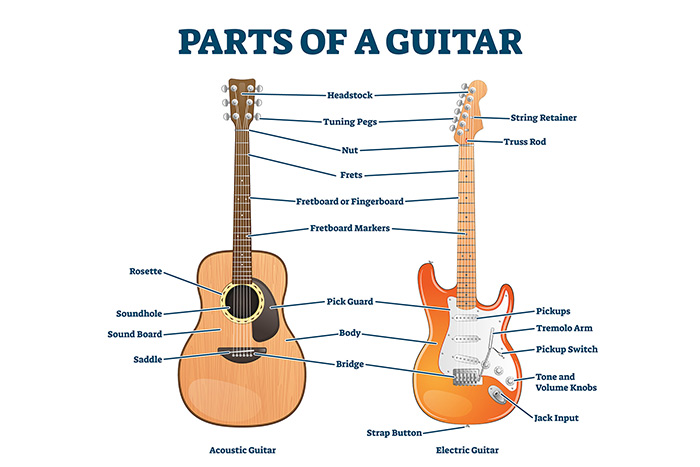Listen to the bass!
Learning songs by ear is a lot of fun, and a skill that will come in extremely handy for you both at home for your own enjoyment and in jam sessions/rehearsals when you need to be able to pick things up quickly without TAB’s or sheet music.
When starting off on your ear training journey, keep things simple and try to learn a simple four-chord-song that will have pretty straightforward information for you to transcribe. Let’s take “With Or Without You” by U2 as our first example. This will use the same four chords the entire way through the song, so nice and easy to start with.
So the first place that you’re going to want to start with a song like this is the root notes of each chords or the bass notes, which is the lowest note of the chord without worrying if it is major, minor, or anything else just yet.
You could either try to listen to the lowest note that you hear in the guitar or keyboard chords (try humming it then find on the guitar neck) or even better if that bass guitar is playing this root note in a consistent fashion, that will give you something nice and clear to zone in on.
In this particular song the bass is playing the root notes in a driving 8th note pattern, which makes this super easy for us to hear. Find where each of the root notes are on the guitar then you are ready for the next step. SPOILER’S BELOW:
Bass guitar root notes:
D -A – B – G
Find the chord quality
The root note will be the most important starting point for us, as without this we really have no context of what each chord is built up out of, but the next step will be to determine whether each chord built off of these root notes is major or minor.
There are of course many other types of chords that we could have (major 7, minor 7, dominant 7, minor 7b5, diminished 7, dominant 7th #9 et.) but let’s keep it simple for the moment and just worry about triads.
So you may have heard the analogy with triads that major chords sound happy and minor chords sound sad, and if you hadn’t heard that before now you have! This will be important for us to remember when isolating the sound of each individual chord when learning a song by ear.
Let’s listen to the first chord of this progression, with the root note D. Does this chord sound happy or sad?
Next chord, A? I would argue that both of these have a similar quality, and a happy sound, so both should be major!
What about the B chord? This one has a bit of a different feeling to it, more melancholy. Let’s go ahead and assume that this means that the B chord is a minor.
And lastly the G chord, this one gives me a similar feeling to the first two chords, so it must be major! Now let’s put everything together and strum each chord once each to check if it sounds right.
Try this with the song playing in the background as well to hear if everything is matching up. Does it sound correct?
I think so! This means that our chord progression is:
Chords:
D (major) – A (major) – B (minor) – G (major)
Assign a strumming pattern
Ok so now we have our chords, but the song would sound pretty boring if we just strum each chord once each the entire way through, so let’s add in a strumming pattern to give it some rhythm! There are a few ways that you can go about this.
If a song already has a very prominent strummy guitar then it will be best to copy this rhythm exactly, listening for where the gaps are and where the faster strums are.
The general rule for strumming is that if a strum lands on the down beat (1 – 2 – 3 – 4) then we strum downwards, and if it lands on the off beat we strum upwards (1 “and” – 2 “and” – 3 “and” – 4 “and”).
This would be the case for a song like “Riptide” by Vance Joy, which has a very prominent strumming pattern (although played on a ukulele). It would only take you a few listens to be able to transcribe the rhythm of this, which you could first do by clapping or tapping out before converting to strumming on the guitar.
(SPOILER: this strumming pattern should be DOWN DOWN – UP DOWN UP in each bar. Why don’t you try and figure out the chords to go with that?).
But what if there is no prominent guitar strumming pattern, like in “With Or Without You”? In this case we should listen to the bass and drums to see which beats in the bar they are accenting to give us an idea of what sort of rhythm we should be strumming the chords in.
A great exercise to check if your strumming pattern is ideal is to play this by yourself without the song playing in the background, and seeing if your strumming pattern gives you a similar groove and feeling to what you get when listening to the song.
Or better yet, try playing this for a friend and see if they can recognise the song just from your strumming of the chords.
Find your key centre
If a song is a bit more single-note riff or melody based you could follow the same steps as when we first found the root notes of each chord, just zoning in on each individual note of the riff until you have transcribed the whole thing.
You could also give yourself a few more parameters by first trying to identify the key centre of the song. Is there a note that the riff keeps coming back to, either starting on or ending on, there is a good chance that this could be the root note of your key centre.
Let’s take “Seven Nation Army” by The White Stripes for example. This riff always starts on the same note (E) each time, so it would be safe to assume that this is the key.
But how do we know if the key is E major or E minor? Do you know the major scale? How about the natural minor (or minor pentatonic) scale? Great! (If you don’t know those yet, go and learn then).
Now try playing both of these scales on top of the song playing in the background to see which one sounds like it fits. One should be blatantly obvious that it doesn’t, which in the case of this song would be the Major scale that doesn’t fit. This gives us the key centre of E minor.
Now that we know the key, we know that there are only (most likely) 7 different notes to choose from, rather than 12 if we were just taking a stab in the dark of which notes we were looking for, which will help us to narrow down the notes used in our riff.
In the case of “Seven Nation Army”, these notes are all found directly in the E natural minor scale and pretty much go straight down the scale for most of the riff. So we know that this riff:
-Starts on E
-and uses the E natural minor scale
Why not try and learn the rest of this yourself!











